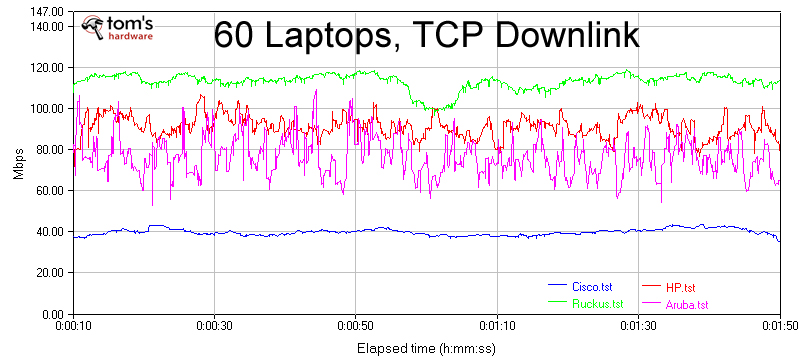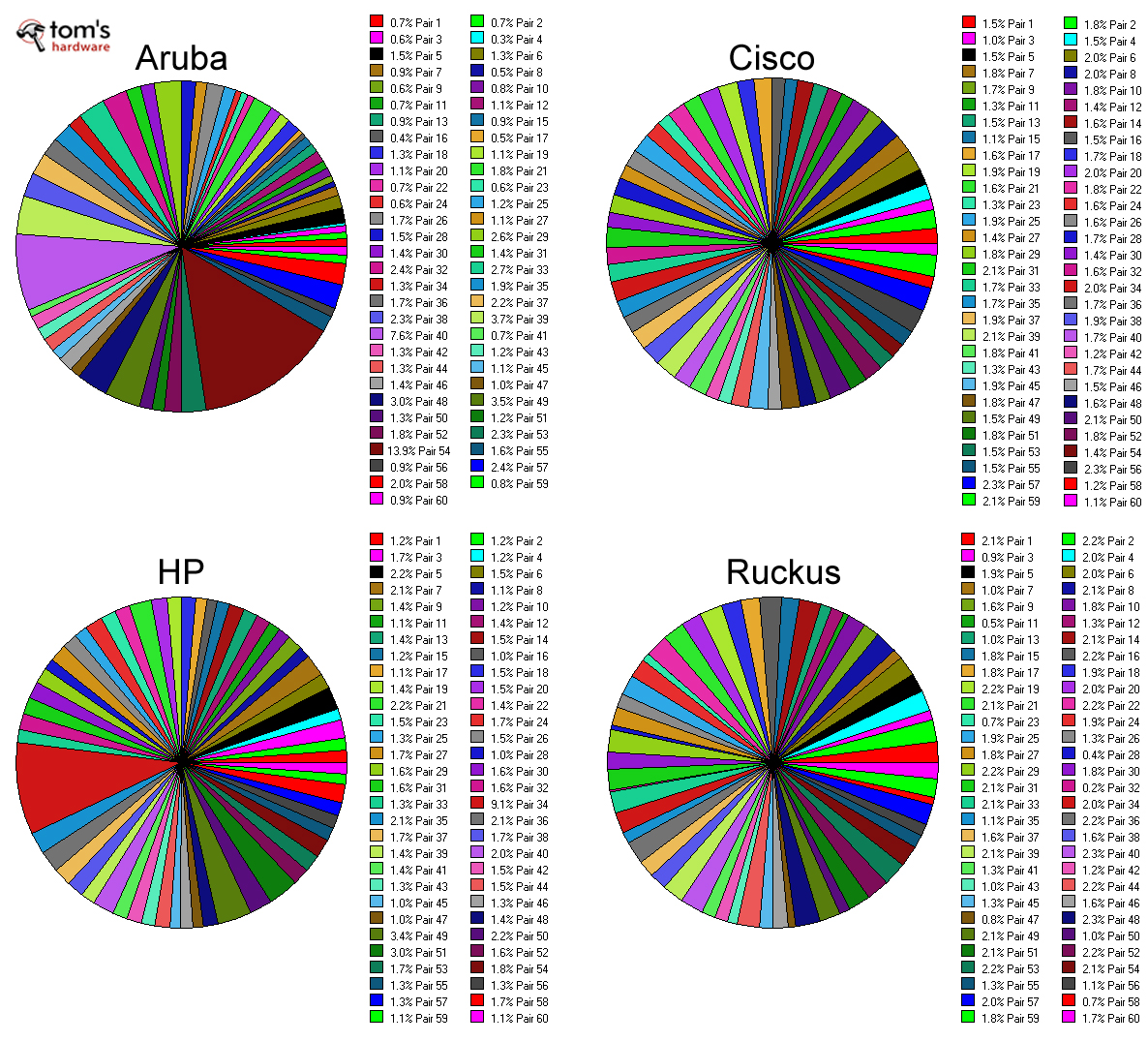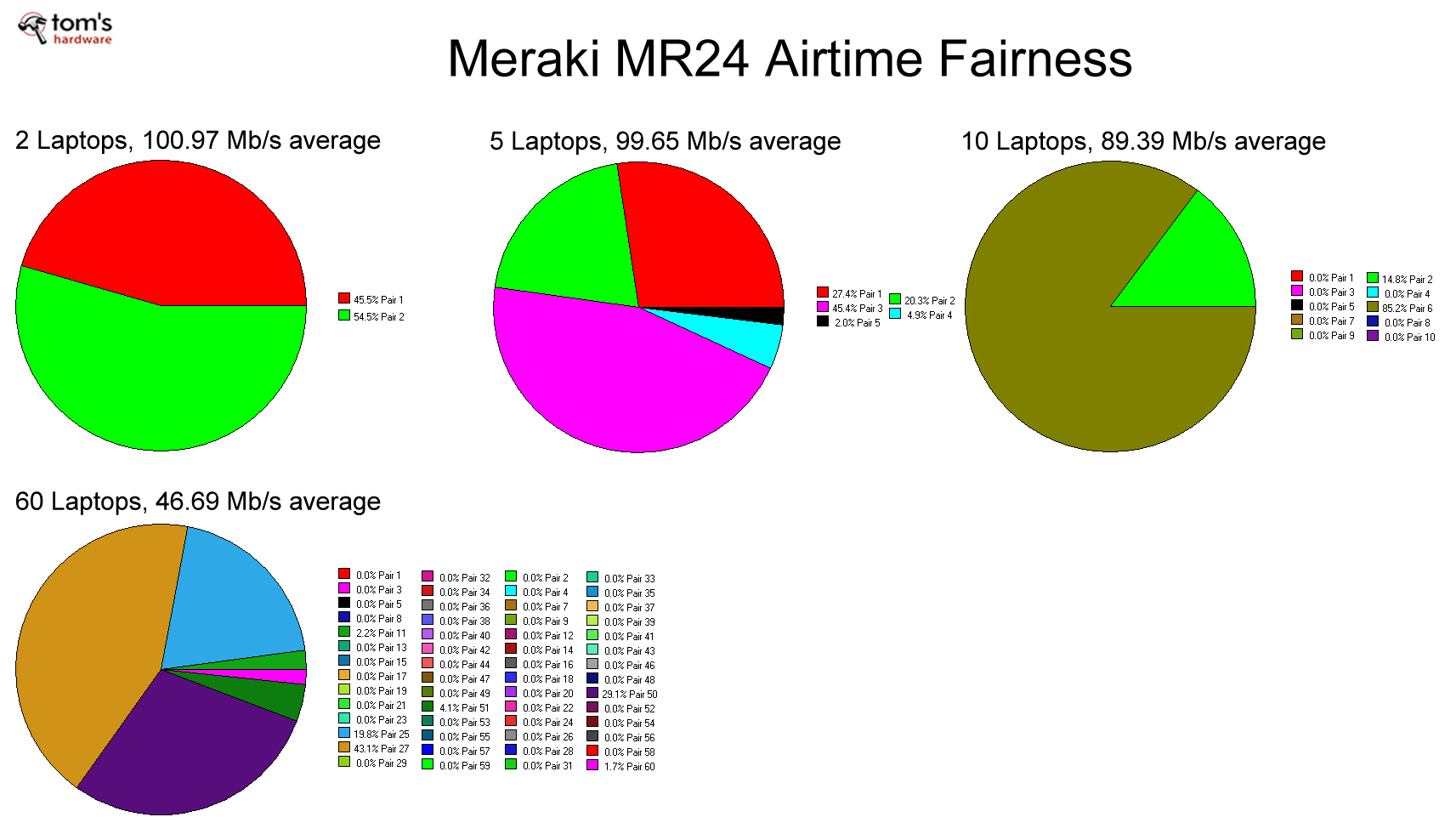Why Your Wi-Fi Sucks And How It Can Be Helped, Part 2
In Part 1, we explained what can go wrong with Wi-Fi signals and how access points can work to improve your wireless performance. It's time for a reality check. We throw six contenders against 65 clients and some hellish interference. Who's left standing?
Airtime Fairness Under Pressure
Just to make this airtime fairness point even more explicit, let’s dig into a further breakdown of access point performance. Going back to our 60-laptop downlink tests, the original throughput chart of the four survivors looks like this in IxChariot:
As we saw in the bar graphs, Ruckus tops the field, HP and Aruba battle for runner-up, and Cisco pulls along slow but steady around 40 Mb/s. The extra insight you get here is that HP demonstrates a tighter bandwidth range than its Aruba counterpart, making it an even better choice between the pair.
Now look at how these four APs divide up their bandwidth on a per-client basis. You’ll want to click on this image to see it at full size.
Cisco and Ruckus both do excellent jobs at making sure each client gets a fairly equal slice of the available bandwidth. HP does fairly even work, save for that one 9.4% slice. Aruba, which did not have airtime fairness enabled, slips even further, giving over 20% of the bandwidth pie to only two clients, leaving that much less for the other 58.
But even Aruba’s favoritism can be overlooked in the face of Meraki’s egregious, haphazard allocations. We ran a sequence of tests on the MR24, looking to see how the AP handled fairness under increasing load. The results are very telling.
Notice that the aggregate bandwidth with five laptops is almost on par with that of only two laptops. However, even with only five laptops in play, one client receives 45% of the bandwidth while another gets just 2%. Remember that these notebooks are all identical in both hardware and software configuration. There is no reason at all for the access point to favor one client over another. With 10 clients, this simply turns ridiculous. One client gets 85% of the bandwidth and eight clients get absolutely nothing. Yet the aggregate bandwidth still reports as almost 90 Mb/s, which sounds rosy on its surface. Out of 60 laptops (before the AP gave up trying), only three received any appreciable bandwidth; 54 received no data at all.
Get Tom's Hardware's best news and in-depth reviews, straight to your inbox.
Current page: Airtime Fairness Under Pressure
Prev Page Mid-Range, iPads And Laptops Aggregate Next Page Wrapping Up-
winner4455 Hey, I still haven't read this article but right away I notice the new format. Just thanking you for listening to your readers! :)Reply -
cangelini Very welcome Winner. We thought the picture story format would work for that last part and didn't realize the text would come out to be so terrible. From now on, we'll only use picture stories when the captions fit without requiring another click!Reply -
tacoslave cangeliniVery welcome Winner. We thought the picture story format would work for that last part and didn't realize the text would come out to be so terrible. From now on, we'll only use picture stories when the captions fit without requiring another click!"Now thats what i like to hear!"Reply -
nekromobo What if you add few thin-foil balls to room (the size of fist or 2)Reply
That should add few rf-reflections or paths, right?
Just your 2cent amplifier.. :) -
I wonder why you didn't include Juniper products (formerly trapeze)to this test. It's quit a big player here in europe. Trapeze also produced the 3com wireless manager and accesspoints which was sold widely here.Reply
-
Hupiscratch In the page "Benchmark Results: Close Range, No Interference", the HP AP is missing on the downlink graph.Reply -
Onus This was an outstanding article. Going just by this, Ruckus and Cisco are the only two I'd consider out of the box, but it would be very interesting to do a follow on that features even a minimal amount of tweaking to see what changes. A consumer expects a product to work well out of the box, but an enterprise network engineer almost certainly does not.Reply
-
Very thorough. Lots of hard work went into this and it shows. But how did you select client devices? Did you try any other chipsets? We tried something like this with more diverse clients and got results that were too variable to reach conclusions. (Some clients just did better with some APs than others.)Reply


